Introduction
Since 1925, leasehold and freehold have been the two common ways to own land in England and Wales, statutory provisions for which are covered in the applicable acts- the Law of Property Act 1925, the Leasehold Reform Act 1967, the Landlord and Tenant Act 1987 and the Leasehold Reform, Housing and Urban Development Act 1993. Out of the two tenures, freehold is akin to absolute ownership whereas leasehold covers ownership for a temporary period, usually 99 years(1). The residential sector in the UK resembles a vertically expanding and characteristically mixed structure or inter-dependent form of development where residential properties are owned by residents or individuals as leaseholds and the common properties are owned as freeholds by a company representing the tenants or by any independent landlord(2). This means, the individual flats of an inter-dependent property like apartment block or multi-apartment housing are actually not owned, rather possessed by the respective owners as leaseholds, usually for a tenure of 99 years or more, as per the provisions of the Leasehold Reform Acts. On top of this provision for fixed tenure possession of leaseholds, another provision exists that confers the ownership of the common parts on a freehold basis either to a company representing the tenants or to any landlord independent of the tenants.(3)
Since its inception, the leasehold system was found to be intrinsically complex having some problems of its own. In real terms, leasehold does not confer ownership, it only gives the right to occupy or use a property for a certain period of time or tenure as agreed in the terms of the contract. The lease, as it progresses towards the end of its tenure or expiry date, finds its asset value diminished consequently leaving the leasehold interest lower for the leaseholders(4). Moreover, there also has been the problem of enforcement of covenants(1). The leasehold system is open to enforcing both restrictive and negative covenants, i.e., a leaseholder can modify or erect additional structure within his leasehold property and he has to ensure that his property is not used for any other purposes other than residential purposes or other than what it is agreed for in the contract(5). On the other hand, it may be possible to impose restrictive covenants in the case of the freehold property but imposing personal or positive covenants is not possible in this case.
The above problems have been well recognized and in order to address these, the government has come up with the Leasehold Reform Act 1967 and the Leasehold Reform, Housing and Urban Development Act 1993. However, these reforms failed to bring in much improvement as anticipated compelling to continue the search for a fruitful solution(6). This search finally culminated with the introduction of the Commonhold and Leasehold Reform Act 2002, which was granted the Royal Assent on 1st May 2002. This Act introduces a new form of property ownership termed as ‘Commonhold’, which is claimed to be a better alternative to the leasehold system. This new system was meant to be an improvement to the existing freehold and leasehold systems and the government introduced this with the hope of solving the long-standing problems and disputes associated with the leasehold system(7).
Now that the Commonhold and Leasehold Reform Act 2002 has already been introduced, there is growing curiosity to have a first-hand impression about the application and effectiveness of this new Act. Particularly, it is of utmost importance to assess and verify how and to what extent, has this new Act succeeded in solving the long-standing problems and disputes of the leasehold system. Aiming to address the above queries and assess, for real, the present regulatory scenario pertaining to landholding and property ownership in the UK, an exploratory research study has been conceived, the findings of which have been presented in this report. Starting with this introduction, this chapter (Chapter-I) proceeds to give a brief premier of the overall study including the research problems, main objectives, study methodology and other related issues.
Research Problem Statement & Objectives
In the UK, the leasehold and freehold systems of landholding have been in force for a long. The leasehold system soon came under the scanner owing to some practical and interpretational problems(1). The leasehold system lacked a proper balance of power between the landlord and the tenant injecting a sense of insecurity for the leaseholders. The lease proved to be a diminishing asset losing substantial values as it moves closer to the expiry date of its tenure(4). The problems multiply in case of an inter-dependent or mixed property as such property generally has two forms of ownerships- leasehold ownership and freehold ownership. Further, another problem common with inter-dependent land-holdings has been the problem of enforcement of covenants. The leasehold portion is open to both restrictive and negative covenants whereas, the freehold part is open to enforcing only restrictive covenants(5) having no scopes for enforcement of the personal or positive covenants. The government has not been unaware of these problems and it has intervened to solve the problems through reforms such as the Leasehold Reform Act 1967 and the Leasehold Reform, Housing and Urban Development Act 1993. However, even these reformed Acts seem to have failed to deliver so far as the problems of leasehold are concerned. Finally, during 2002, the Commonhold and Leasehold Reform Act 2002 has been introduced with the ambition of doing away with the problems inherent in the leasehold system(8). Thus, taking stock of these facts, the major problems of land-holdings in the UK can be listed as below:
- There have been disputes, balance of power problems, property management issues and covenants enforcement problems with the application of both the leasehold and freehold ownership forms particularly in case of inter-dependent or mixed property in the UK.
- The problems of the leasehold system remained even after reformation of the original leasehold Act on two occasions (1967 & 1993) paving the way for introduction of the Commonhold and Leasehold Reform Act 2002.
- There exist similarities as well as differences between the UK Commonhold system and other similar land-holding systems in the world.
- The Commonhold form of land holding is a voluntary initiative and not a binding in the UK. Given this, there might be some slackness in real uptake of this new option of land holding. Research on the perceptions of the landholders and practical studies exploring this aspect are rarely available leading to problems of knowledge gaps.
This study seeks to address the above problems. With this mission at hand, the study proceeds to explore and achieve a set of objectives or milestones pre-identified for this purpose. The main objectives are to:
- Review the land-holding system of UK.
- Critically evaluate, compare and contrast different land-holding options in UK and establish whether the commonhold is really an improvement to the freehold and leasehold land-holdings.
- Investigate what the UK landholders perceive about the commonhold system and accordingly recommend for further improvements.
Research Methodology
Selection of appropriate methodology is very vital so far as the quality and reliability of research output are concerned. The study at hand essentially falls under the domains of legal studies with special focus on UK’s land holding system. Having considered the research objectives, it has been decided to carry out an exploratory research in this case. This study follows a mixed approach combining both secondary research and primary investigation. The secondary research includes a detailed review of the existing literature, prior-arts and other secondary information sources. In case of the primary research, it has been decided to conduct a simple survey of landholders using a semi-structured questionnaire. A complete description of the methodology, data collection approach, questionnaire design, etc. has been covered in Chapter-III.
Report Layout
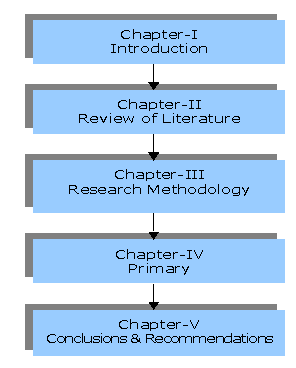
Figure-1.1 below outlines the layout of the study report. Beginning with this introductory chapter (Chapter-I), this dissertation runs into five chapters in all (Chapter-I to V).
Chapter-II presents the secondary research with a detailed review of the available literatures pertaining to land holding on organizational development and change management with specific reference to customer services. The next chapter, Chapter-III describes the study approach and the research methodology followed by Chapter-IV, which presents the primary research and case study findings. The dissertation concludes with Chapter-V highlighting the conclusions and recommendations.
Review of Literature
Introduction
The housing or residential sector in the UK is well established. Flowing with the waves of modernization, there has been exodus of people in the urban centers leading to exponential growth in demands for housing. This in turn sparked off ceaseless development & re-development works and vertical expansion of residential infrastructures in the urban areas that marked the beginning of the era of mixed housing, residential blocks and inter-dependent housing. This further witnessed development of various housing finance schemes, different land-holding ways and options like the leasehold, freehold and the recently introduced commonhold system(7). In case of blocks or inter-depended property, it has been a common practice of splitting the ownerships into two forms-the leasehold system and the freehold system and this pattern followed since 1925s.
There have been some problems inherent with the leasehold system particularly concerning balance of power between the tenet and the landlord, management conflicts and limitations in covenants enforcement(4). In order to tackle these problems, the government has reformed the leasehold Act on two occasions- the Leasehold Reform Act 1967 and the Leasehold Reform, Housing and Urban Development Act 1993. These two reforms brought about some changes but were not sufficient enough to eradicate the long-standing problems of the leasehold system. Search continued for a lasting solution to the problems until 2002, when the Commonhold and Leasehold Reform Act 2002 was introduced with the aim of making the whole process of land-holding simple & straightforward for the land-holders and also providing lasting solution to the leasehold problems.
Taking on from here, this chapter (Chapter-II) goes on to present a critical review of the land-holding systems and the related legislations and reforms initiated in the UK. Available literature, government publications, existing research studies and recent legal proceedings have been thoroughly scanned through and explored to present a realistic picture of the situation. Wherever possible, it has been tried to backup and substantiate the findings of the review by gathering evidences from actual court cases and legal deliberations relevant to this subject area.
The UK Housing Sector
The UK housing sector is well established, but unlike other sectors, this sector has been somewhat volatile in recent years. The price of new homes went up by 126% over the last 10 years and housing inflation touched 159%(9). As in many other countries, UK too faces mismatch in housing demand and supply. The UK government plays an active role in housing development and the government strives to provide “the right type of property, in the right location, at the right price”(8).
Housing infrastructures are mostly concentrated in the city centers and the urban areas of UK. Flowing with the waves of modernization, there has been exodus of people in the urban centers leading to exponential growth in demands for housing. This in turn sparked off ceaseless development & re-development works and vertical expansion of residential infrastructures in the urban areas signifying the beginning of the era of mixed housing, residential blocks and inter-dependent housing. This further witnessed development of various housing finance schemes, different land-holding ways and options like the leasehold, freehold and the recently introduced commonhold system(7). In case of blocks or inter-depended property, it has been a common practice of splitting the ownerships into two forms-the leasehold system and the freehold system and this pattern followed since 1925s. There have been some problems inherent in the leasehold system, particularly concerning balance of power between the tenet and the landlord, management conflicts and limitations in covenants enforcement(4). In order to tackle these problems, the government has reformed the leasehold Act on two occasions- the Leasehold Reform Act 1967 and the Leasehold Reform, Housing and Urban Development.
Shifts in Housing Structure
The UK is the earliest urban industrial society(10) and thus its urban structure has a historic touch as manifested in the older classical housing lots the last traces of which exist even today. Therefore, Britain has a legacy of old-fashioned housing resembling the footprints of 200 years of industrial history(11). Naturally, the Britishers happen to be the first to hone and master the art of community living, the science of housing construction & design, the economies of housing finance and the intricacies & expertise of housing development policies, legislations and land-holdings. Soon, environmental concerns of scattered and unplanned housing, public health issues and the desperate needs for balancing housing demand and supply pushed the government to intervene in this sector(4). This is when the government concentrated on housing development and re-development or regeneration and started encouraging public bodies and landlords to participate in this housing development mission.
Proceeding in this direction, the government went on to invent an enduring and successful housing form and step into a new era off individually owned inter-dependent properties such as flats within a tower block, Multi-flats apartments, group housing, etc. Thus, the UK housing structure changed from the single ownership housing to mixed or interdependent housing as shown in Figure-2.1.
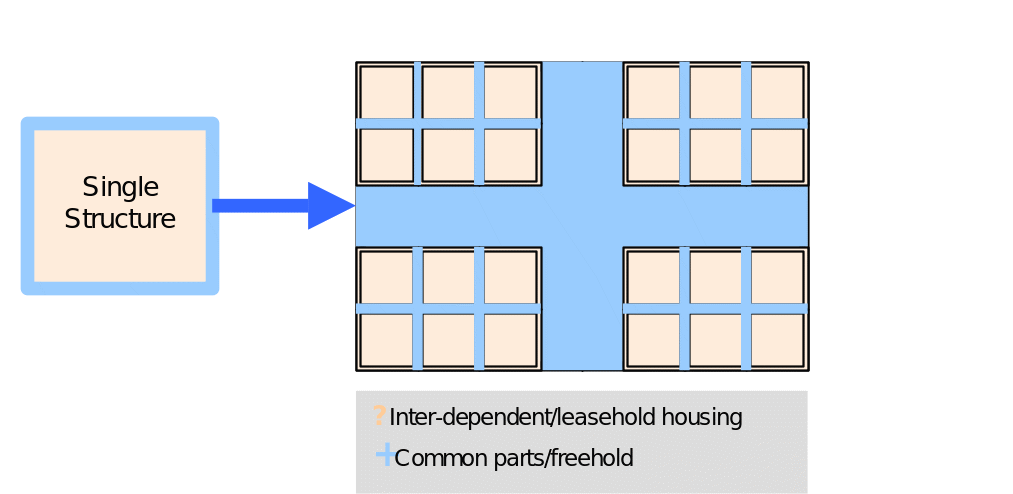
Leasehold, Enfranchisement & Lease Extension
Housing in England and Wales is now predominantly of the mixed structure built on inter-dependent properties. Flats in tower blocks and composite accommodations are growing in numbers day-by-day. Such blocks generally have multiple flats and living rooms meant for living purposes all of which are inter-dependent having common parts, structures and facilities which the owners of every flats can put to their use as and when needed. The flats can be individually owned or possessed whereas the common parts cannot be occupied on individual basis.
The individually owned flats or inter-dependent properties like individual flats in a housing-block are generally developed and sold on leasehold basis(1). This leasehold system has been in operation in the UK ever since the enactment of the Law of Property Act 1925. As per the leasehold arrangement, the individual who pays for the leasehold cannot actually be the real owner of the property in true sense of the term. He actually acquires the right of occupying or using the property for a fixed period of time or tenure as agreed in the lease contract, usually for 99 years or more. The common parts on the other hand are usually owned as freeholds by a company of the tenants or by a landlord independent of the tenants. This arrangement is required because there is no generally satisfactory way of binding future owners of freehold land to do something such as repair a structure. In legal terms, the burden of a positive covenant does not run with freehold land(4).
There are approximately one million long residential leaseholders in the England and Wales. Every year, 20 to 40 thousand new flats are constructed and as much as 130,000 leases having tenure of over 21 years are registered annually in the UK(12). There are two principle problems with the leasehold system. First, the lease is a diminishing asset so as time progresses and the lease comes nearer to its expiry date the value of the leasehold interest tends to diminish. Successive Governments have sought to address this problem principally through the leasehold reform legislation starting with the Leasehold Reform Act 1967 which introduced the principle that long lessees of houses could compulsory acquire their freehold. More recently, the Leasehold Reform Housing and Urban Development Act 1993 introduced a right for long lessees of flats to compulsorily acquire a fixed 90-lease extension(13). While these reforms have to some extent addressed the problem many people still feel unhappy with the concept that they only own something for a certain period of time. Secondly, there is problem of enforcement of covenants. One of the strengths of leasehold system is that it provides a way of enforcing both restrictive and negative covenants. This is something that cannot be achieved easily under freehold system. While it is generally possible to impose restrictive covenants on freeholds there is no satisfactory method of imposing positive covenants.
Collective Enfranchisement
Enfranchisement is a right of compulsory purchase that is given for specific reasons of public policy. Most owners of leasehold houses have enjoyed the right to buy the freehold of their property or extend their lease agreements since the enactment of the 1967 Leasehold Reform Act. Leasehold flat owners gained the “right of first refusal” where their landlord wants to sell the freehold under Part 1 of the 1987 Landlord and Tenant Act; they also gained the right to acquire the landlord’s interest in cases of continued bad management(2). Soon after implementation this Act was criticized for loopholes in the procedures laid down for the sale of the freehold: while it was one step on the road to strengthening the rights of long leaseholders, the overall impact of the 1987 Act has been limited. Research carried out by the Department of the Environment in 1991 and the Consumers’ Association in 1992 confirmed the existence of loopholes in the legislation and highlighted the pressure placed on tenants, legally, financially and managerially, that deter them from exercising their rights under it. The 1993 Leasehold Reform, Housing and Urban Development Act gave most long leaseholders in blocks of flats the collective right to buy the freehold of their blocks, or individually extend their lease agreements, irrespective of whether their freeholders want to sell(4).
On enfranchisement the draft Bill included measures that were aimed at:
- Simplifying and relaxing the existing criteria for exercising the right of enfranchisement and removing barriers for which there is no clear policy rationale;
- Reducing the likelihood of lengthy and costly disputes about the determination of the purchase price of the freehold interest;
- Allowing all qualifying tenants an opportunity to participate in the enfranchisement; and
- Providing a standardized, purpose-built company structure for the orderly and democratic conduct of the enfranchisement process and the subsequent management of the building, after enfranchisement.
In January 2001 the DETR published a summary of responses to the draft Bill and consultation paper to which 1,065 responses were received: three-quarters were from leaseholders and the remainder were from freeholders, professionals, social landlords and “Others”.
The Commonhold System
Commonhold system has been introduced to be the third method of owning land that is neither freehold nor leasehold but contains some of the characteristics of both(1). It is not a new concept and has been in operation in other countries under different names (such as condominium or strata title) for many years. In this country the concept of commonhold has been discussed for many years but the Commonhold and Leasehold Reform Act 2002 means it is now a reality. A commonhold will comprise a defined area of land that will include a number of “units” which might be houses, flats, shops or industrial units(14).
Under this system, the owners of each unit will be known as unit holders and will each be a member of the commonhold association. The commonhold association will be a special form of company registered at Companies House and will be governed by a memorandum and articles of association in the usual way although the form of those documents will follow prescribed rules(12).
A commonhold community statement will govern the property rights of the various unit holders and the association itself. This statement must follow a prescribed form but will also to some extent be tailor-made to suit each commonhold. In many ways this document will resemble a lease and will set out each unit holders rights and obligations such as duties to pay service charges, to maintain their units and to comply with regulations for the mutual benefit of all unit holders. The statement will however be common to the whole commonhold, unlike leases, which relate to individual properties. Unit holders of commonhold will have two interests in the commonhold: their own interest in the unit itself and their share in the commonhold association. It will not be possible to deal with one without at the same time dealing with the other.
The regulatory impact assessment (RIA) that accompanied the first Commonhold and Leasehold Reform Bill1 described Commonhold as(13):
“…the name given in this jurisdiction to a scheme widely used throughout the rest of the world with greater or lesser degrees of variation. It provides for multiple occupation of developments, such as blocks of flats, or mixed flats and shops, or business parks in which unit owners have an interest in their unit of occupation, whatever that may be, which is closely analogous to a freehold interest. A body corporate, the commonhold association, made up exclusively of unit holders, owns and manages the common parts of the development, which may be no more than hallways and stairs, but might run to parks, sports halls, lakes, etc.”
According to Rosenberry (2000), there are four types of commonhold communities currently in use around the world. These are:
Condominium- in the condominium or strata scheme the unit owner owners a freehold interest in a unit coupled with a tenant-in-common interest in the common area, and perhaps an interest in an exclusive use common area.
Housing co-operative (company titles scheme in New South Wales)- under this scheme the corporation owns the entire structure and each owner has the exclusive right to possess a portion of the building coupled with an interest in the corporation. This form of ownership is similar to a block of flats where all of the tenants have purchased their flats. Housing cooperatives have been overtaken by the development of condominium and planned community law.
Planned community- the unit owner owns a freehold interest in a separate area, sometimes called a unit or lot, coupled with an interest in the association. The association owns the common area. The unit owner may also own an interest in a proportion of the common area that is called exclusive use common area.
Master planned community- this is a combination of one or more of the above. This form of ownership is viewed as particularly valuable in a mixed-use building where it is desirable to have one association for the commercial property and one for the residential property. Each association has its own common area and rules and each is also subject to the rules of the master association that also generally owns common property. In this case both the commercial and residential owners have voting rights in the master association.
The commonhold will be a voluntary and self-regulating way of owning freehold property. It will be applicable to residential and commercial developments. The main aims of this regulation are:
- To provide a sound legal framework for the running of commonholds;
- To provide standard documentation which strikes the right balance as between different commonholds, permitting necessary variation for individual commonholds; and
- To create a system that is straightforward, inexpensive and simple to run.
To meet these aims, the regulations will prescribe ‘model’ forms for the memorandum and articles of association of the Commonhold Association, the commonhold community statement (‘CCS’) and several forms for use in connection with the CCS. These will replace the memorandum and articles of association of a management company, and the leases, which would feature in a traditional long leasehold development.
Commonhold is a new form of land ownership. It is an alternative to long leasehold ownership of inter-dependent properties. No one will be compelled to adopt it: it will be voluntary. For the property owner, commonhold has two main elements. First, the owner will have direct freehold ownership of an individual property, for example a flat or shop, known as a unit. We refer to the owner as a unit-holder. The unit will typically be part of a larger development, such as a block of flats or a shopping centre. Secondly, the owner will have indirect ownership of the common parts of the development through membership of a company known as a commonhold association, which owns and manages the common parts and facilities. The main differences between commonhold ownership and long leasehold ownership are that(15):
- Commonhold ownership will be in a permanent freehold rather than a lease, which is a wasting asset; and
- The terms, conditions and procedures governing the running of a commonhold and the rights and duties of its members will be largely standardised, unlike leasehold documentation which is different in every development and sometimes defective.
This assessment of the impact of the effect of the proposed commonhold regulations builds on the regulatory impact assessment prepared for Part I of the Commonhold and Leasehold Reform Act 2002 and the partial regulatory impact assessment, which accompanied the consultation paper ‘Commonhold Proposals for Commonhold Regulations’, published in October 2002. The consultation paper sought views on the economic impact of commonhold regulations and its costs and benefits. Approximately 40% of the respondents to the consultation answered one or more of the five questions relating to the partial regulatory impact assessment. The respondents were, in the absence of final proposals for the regulations, cautious about the likely extent to which commonhold would be adopted.
Associated Risks
There are four main risks in making regulations for commonhold(15). First, the documentation might be too complicated; meaning that take up is severely limited because people stick to the familiar leasehold structures. Secondly, the documentation might be too rigid, meaning that it cannot be adapted to the requirements of individual commonholds. This too will prevent take up. Thirdly, the documentation might be so flexible that the limitless variety of leasehold ownership is recreated in commonhold. This would prevent the advantages of standardization being realised, increasing the need for legal advice and costs. Fourthly, the regulations may specify a mandatory requirement that is unacceptable to mortgagees, insurers or property owners. In this case, the requirement in question would prevent commonhold being adopted.
Benefits of Commonhold
Commonhold will, in particular, avoid two of the principal problems with long leasehold tenure. First, leases are wasting assets, usually subject to a right of forfeiture in favour of the landlord, for breach of an obligation. As the remaining term of a lease diminishes, its acceptability as a mortgageable security reduces. Despite statutory rights to extend or enfranchise a lease, concerns relating to mortgageability remain relatively commonplace. Commonhold unit will be freehold and not subject to forfeiture.
Secondly, all leases are individually drafted. It is not known how many are inherently defective but one consultee from the advice sector suggested to us that the proportion might be as high as 10%. Other leases become defective as the requirements of lenders and others change. In either case, once a lease is found to be defective, the defect must be remedied in order to be saleable. It would not, apparently, be untypical for it to cost between £1000 and £3000 to amend a lease to make it mortgageable again. Commonhold documentation will be in large part standardised under the regulations. The standardised parts should not be defective.
The non-standard provisions may not be perfect in every case but their impact on the underlying strength of the freehold security offered should be limited. Written and presented in clear and straightforward language, the commonhold documentation should provide a simpler and more accessible base for the management of a community than traditional long leases, which are written by lawyers for lawyers.
Quantifying the benefit of this desired transparency is not possible. Nonetheless, it should reduce the need to have recourse to professional advisers to interpret the rights and duties of the participants in the community.
Commonhold Vs. Long Leasehold- Comparative Assessment
As has already been mentioned, a precise quantification of the benefits and costs of introducing commonhold – a voluntary system that depends upon many variables – is impossible(15). However, an attempt has been made here for a comparative assessment of commonhold and leasehold (long lese) systems. Table-2.1 shows the comparisons on important aspects like- documentation needs, creation of company, registration, transaction costs, charges, controls & disputes. For better relevance, the information and facts contained in this table have been sourced from the original legislation and the explanatory notes of the Acts as published by the government.
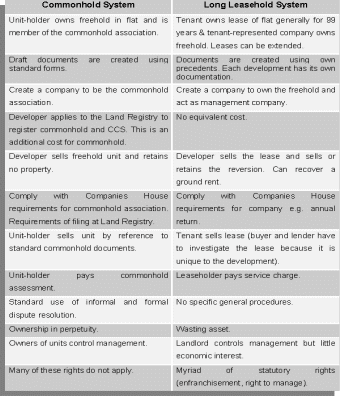
Summary
Thus, the commonhold regulations and the proposed documentation provide a clear legal framework for the operation of commonhold and it can be expected that this approach will bring benefits and allow commonhold to take its place alongside other freehold and leasehold ownership. The long-standing problems of the leasehold system now find a good solution in the commonhold system. Quantitative assessment of the uptake of commonhold system is extremely difficult. Stakeholders say that it is too early to state what the possible interest in commonhold might be. This is because take up will be voluntary and will depend upon the acceptability of the commonhold documentation to prospective developers, lenders, insurers and owners. If take up is significant then the impact will be significant, and if take up is limited then the impact will be limited. At one extreme all new developments, residential and commercial, which might have been sold on a long leasehold basis, might be sold on a commonhold basis and there is no need of any magic to see it for real.
Commonhold can also be created by converting existing developments from leasehold ownership, so at the extreme, long leasehold might be replaced, either for new developments, or for new and existing developments. However, this is believed to be very unlikely, on the basis of comments from stakeholders and experts, particularly in relation to existing developments, given that all of the freeholders and leaseholders must agree to such a conversion to commonhold.
Research Methodology
Introduction
Selection of appropriate methodology is very vital so far as the quality and reliability of research output are concerned. The study at hand essentially falls under the domains of legal studies with special focus on UK’s land holding system. Different research options have been scrutinized and finally a research method has been selected for this study which fits well with the objectives and complexity of the study at hand and which can operate reasonably well under the constraints of time, manpower and finances as common in case of similar academic studies. This chapter (Chapter-III) presents the research methodology as employed in this study. Briefly discussed here are the different research steps and tasks as outlined in Figure-3.1 below.

Research Purpose & Design
The main purpose of this study is to carryout a comprehensive review and comparative analysis of different land holding forms as applicable in the UK-leasehold, freehold and the commonhold land-holding systems. The main objectives of this study have been identified and listed in Chapter-I.
Accomplishment of the objectives demands fair understanding of the concepts of inter-dependent property, land-holdings, different ways of land-holding and other related terms. The overall quality, appropriateness and authenticity of any research study have a bearing on the research methodology and design of the study(17) and as such selection of the methodology that best suits the purpose of the research is a very vital task.
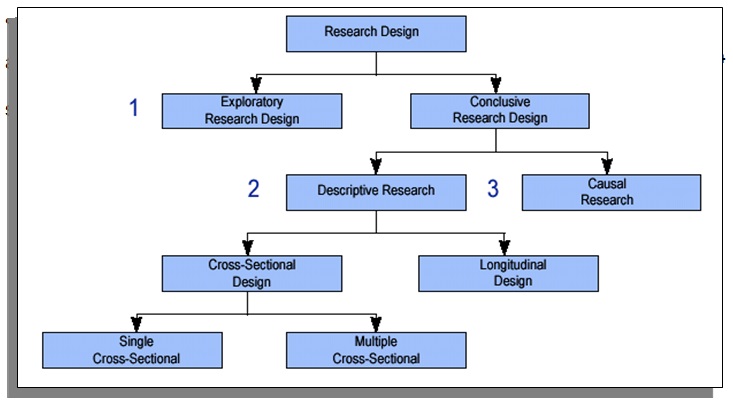
According to Yin (1994), any research has three main purposes- to explore, to describe or to explain(18). As shown in Figure-3.2, a research study may be broadly categorized into three types based on the purposes of the research, which are- exploratory research, descriptive research and causal or explanatory research(19).
Exploratory Research: aims to formulate and define a problem, which is generally difficult to demarcate, when the perception of which model to use is unclear and what qualities and relations that are important are diffuse(19). According to Patel & Tebelius (1987), ‘the purpose of exploratory research is to gain as much information as possible about a specific problem’ (20). In this type of study, the researcher gains better understanding of the research area (21).
Descriptive Research: is a form of conclusive study. It uses a set of scientific methods and procedures to collect raw data and create data structures that describe the existing characteristics of a defined target population or market structure (22). This is usable when the problem is relatively clear and structured.
Causal Research: is also a form of conclusive research, which is designed to collect raw data and create data structures and information to model cause-and-effect relationships between two or more variables (22).
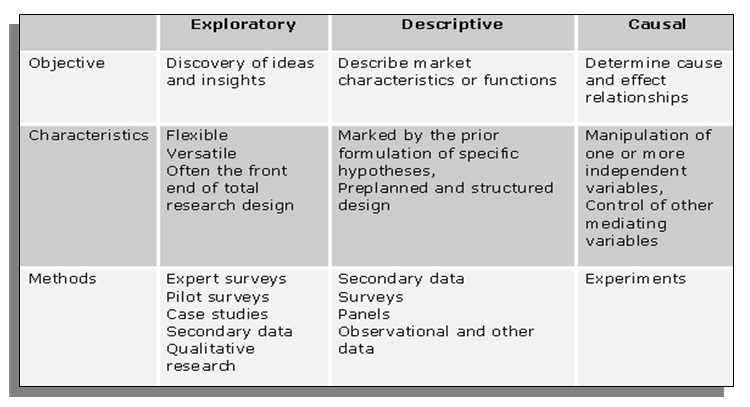
In this study, the long-standing problems of leasehold and different land-holding ways including the commonhold have been explored in order to understand them better under the present conditions. Thus, from this angle, an exploratory research appears to be appropriate for this study.
Research Approach
According to Yin (1993), ‘the research approach refers to the chosen way of treating and analyzing the selected data which is generally classified as either quantitative or qualitative(23).
Quantitative Approach: it is formalized and structured and the results are measurable and presentable in figures and graphs (24). It aims at generalizing by studying few variables on a large number of entities (22).
Qualitative Approach: the main objective here is to gain a variety of preliminary insights to discuss and identify decision problems and opportunities (22). It provides in-depth, non-numeric information and involves collection and analysis of data concerned with meaning, attitudes and beliefs (25). This method is cheaper than quantitative research and is thus a popular option (26).
In true sense, land-holding particularly in case of mixed or inter-dependent property is a complex issue. Beside finances, space/area & other physical parameters, owning a property is also influenced by the perceptions and thinking of the owner as well as the mind-set of the developer and other stakeholders, which are intangible and thus cannot be expressed and quantified in weights and measures under any physical scale (27). Moreover, there exists wide variation in our understanding of various property related legislations and concepts. Assessment of different land-ownership systems and mixed-housing concepts is thus not feasible by applying just one approach and so it has been decided to employ a mixed research approach combining both quantitative and qualitative methods.
Research Strategy
Research strategy outlines the methods for collecting empirical data to be used for the study. The selected research strategy necessarily depends on the characteristics of the identified research questions. According to Yin (1994), a researcher can select any of the following alternatives (Table-3.2) depending upon the form of research questions, required control over behavioral events and whether focus on contemporary events is required or not(23).

The three research objectives as identified in Chapter-I can be transformed in the form of research questions. The objectives then reads- how has the land-holding system in UK changed? How do different ways of land-holdings compare each other? and what are the perceptions of UK landholders about the commonhold system?
Clearly, the questions are of the ‘how’ and ‘what’ types. Now, matching with the situations given in Table-3.2, survey appears to be the best fit and thus, survey strategy has been selected in this case.
Method of Data Collection
Data collection is another vital involvement in a research study. Signifying data collection as a source of evidence, Yin (2003) identified six (06) qualitative empirical data collection forms or ways, as listed in Table-3.3 (23).
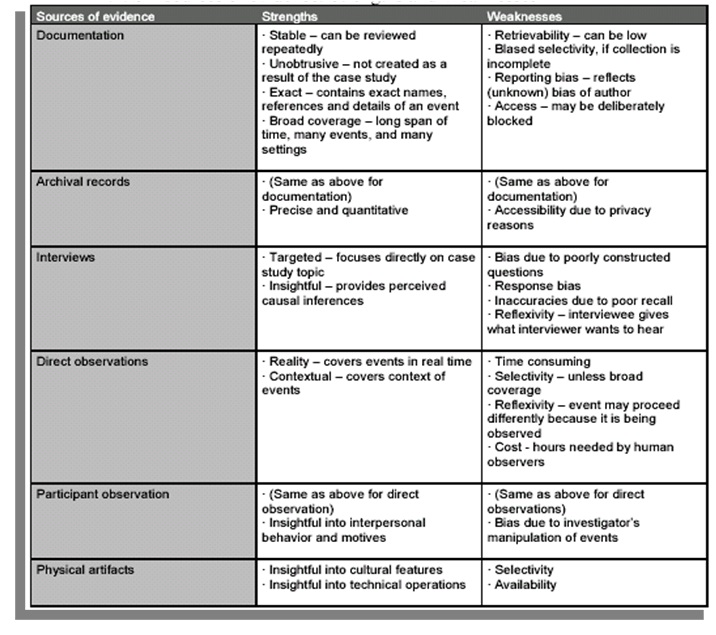
The data collected in course of a study can be further grouped as primary data and secondary data(28) as outlined in Table-3.4.

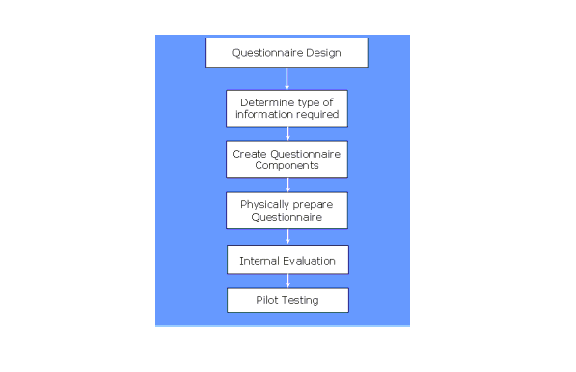
Primary data collection for a study can be done through interviews and questionnaire surveys whereas secondary data can be collected through searching prior-arts, literatures and internet/websites. Here, both primary as well as secondary data and information have been used.
Design of Questionnaire
As decided, the primary data have been collected by conducting a survey of property developers in the UK. For this, a questionnaire has been prepared following the steps as shown in Figure-3.5. The questionnaire contains ten (10) simple questions mainly pertaining to UK land-holding and property structure. The questionnaire designed for this study is enclosed in Appendix-A.
Sample Selection
The housing and property developers of UK have been selected as the respondents for this survey. The next chapter (Chapter-IV) discusses more about the sample.
Data Analysis
Data analysis involves examining, categorizing, tabulating or otherwise recombining the collected data. Here it is an exploratory study, which mostly targets to capture developer’s perceptions about UK land-holdings. Quantitative and numerical information and data were minimum and there was no requirement for using statistical or mathematical software/programmes as such.
Conclusions
Thus an exploratory research methodology has been followed to carry out this research study. The selected methodology includes a questionnaire survey. The collected information were predominantly of the qualitative type with only limited quantitative figures which have been analyzed for accomplishing the research objectives. The next chapter (Chapter-IV) presents the results.
Survey Findings & Conclusion
Introduction
This chapter presents the findings of the questionnaire survey. The results presented here are as per the sequence of the questions contained in the survey questionnaire. Finally, these findings and findings of the literature review (Chapter-II) have been corroborated to address the research objectives. This chapter concludes with a set of recommendations.
Conduct of the Survey
It was decided to carryout a simple survey through a semi-structured questionnaire developed specifically for this purpose. Taking inputs from the literature review and referring similar surveys undertaken by the Royal Institution of Chartered Surveyors (2001) and the Department of Constitutional Affairs (2004), the questionnaire has been prepared that consists of a total of 10 questions as enclosed in the Annexure-I. The questionnaire was pre-tested by visiting two local housing developers and discussing face-to-face on the relevance and sufficiency of the questions it covered. This discussion lead to identification of some mismatches, which were immediately rectified to get the final questionnaire.
For selecting the samples, the list of registered construction companies and housing developers as maintained by the Department of Trade & Industry (UK-DTI) has been used. The list provides the identities, addresses and e-mail IDs of the respective firms. The top 100 firms of the DTI list have been selected and the questionnaire was sent via e-mail to each of the 100 firms. After reminders and follow-ups, only 46 companies responded. Thus, the response rate here is 46%. The next section presents the findings of the survey. As far as possible, it has been attempted to present the findings in easily understandable figures and tables. The findings are presented as per the sequence of the questions as they come up in the questionnaire.
Ownership status of the surveyed companies
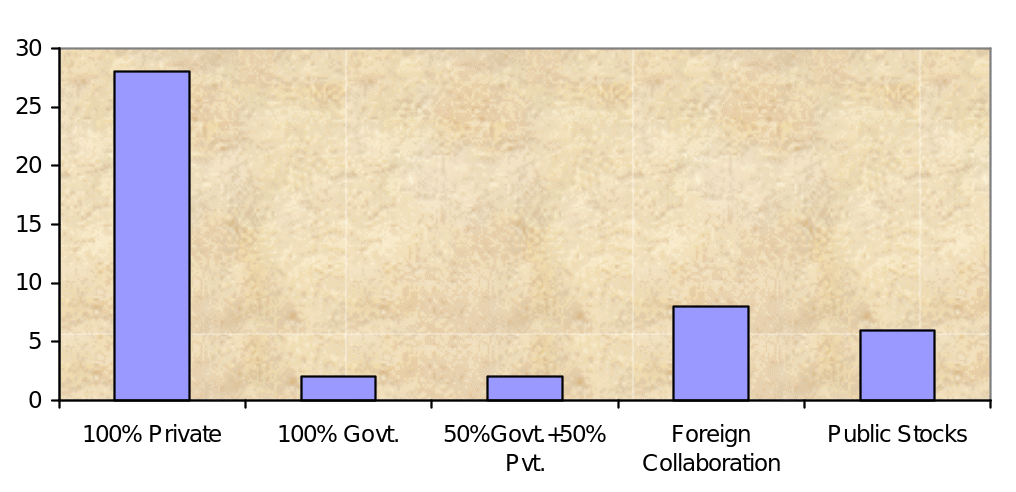
The ownership status of the surveyed firms is depicted in Figure-4.1. Clearly, a good majority of the companies are privately owned while least numbers of companies are government owned. Foreign collaboration and public stock also appear to be picking up.
Changes in Business Conditions
Regarding changes in business conditions, as much as 59% of the companies feel that there is now severe competition in the market. Then come stringent regulations as endorsed by 21% of the companies. 18% respondents also claimed that modern customers are very choosy and unpredictable (Table-4.1).

Profitability of the Companies
As shown in Table-4.2, housing construction firms in the UK are losing their profitability in recent years. The concern here is that loss making firms are growing in numbers along the years.

Company Staff Strength in UK
Figure-4.2 gives an impression of the staff-strength of the surveyed companies. According to this, 28 out of 46 firms surveyed indicated that their work-force strengths fall in the 20-100 range implying that these are basically the small & medium enterprises. The surveyed sample includes only two big firms having staff-strength in the range of 1000-5000. There also are two very big companies in the sample having work force of above 5000.
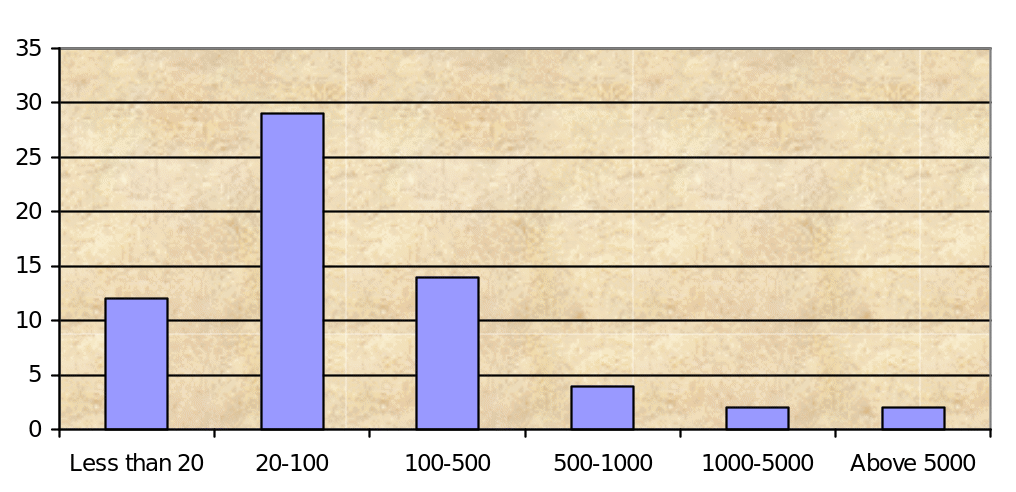
Consideration for Building Commonhold Development
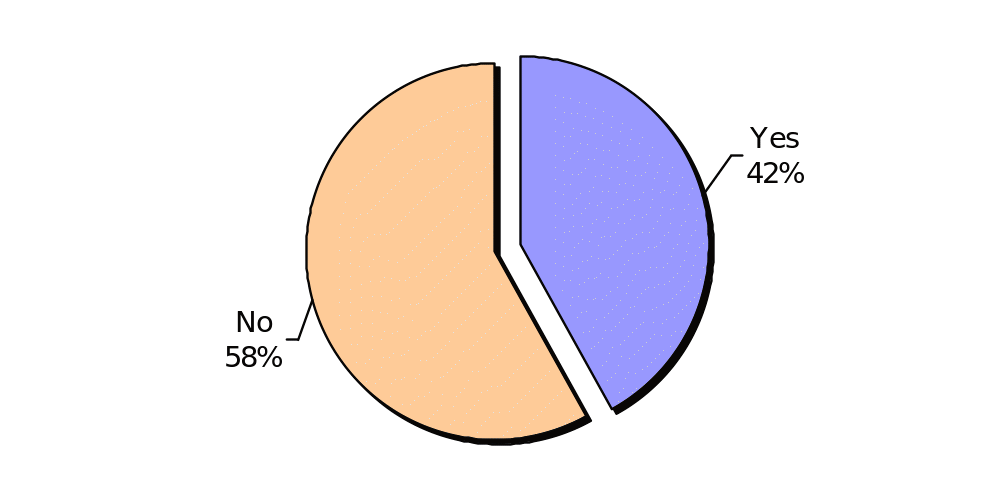
When asked if their companies are considering building commonhold development with the introduction of the new Act, 58% respondents informed that they are not considering this option. On the other hand, 42% expressed the willingness of their companies to embark into commonhold development.

Commonhold Development Likely to Build Initially.
When asked about their desire to build commonhold development at the initial phase, most of the respondents declared that they would prefer not to build any commonhold development. Though on the lower scale, there are few companies who would go for building 1 to 5 commonholds and even 6-10 commonholds (Figure-4.4).

Type of Commonhold Preferred
As shown in Figure-4.5 above, residential property appears to be the most preferred property type as indicated by the respondents followed by residential-mixed property as the second most preferred choice. Importantly, most of the respondents are not much inclined towards commonhold property.
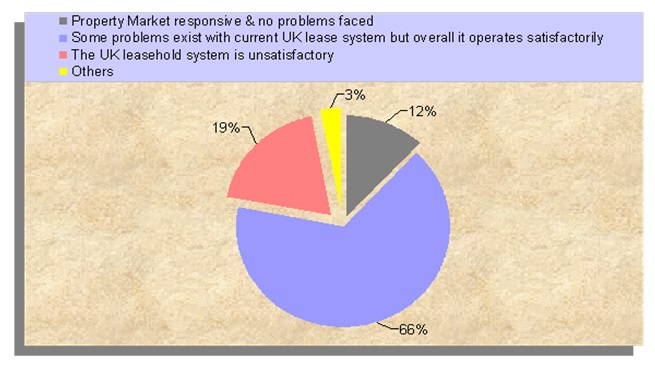
Satisfaction with the UK Leasehold System
Around 66% of the respondents find the UK leasehold system operating satisfactorily as a whole despite some existing problems. As shown in Figure-4.6, only 19% respondents say that the UK system is not up to the mark and 12% straightway expressed that they find the UK leasehold system to be responsive to market changes and they do not find any problems with it.
Problematic Lease Terms/Clauses
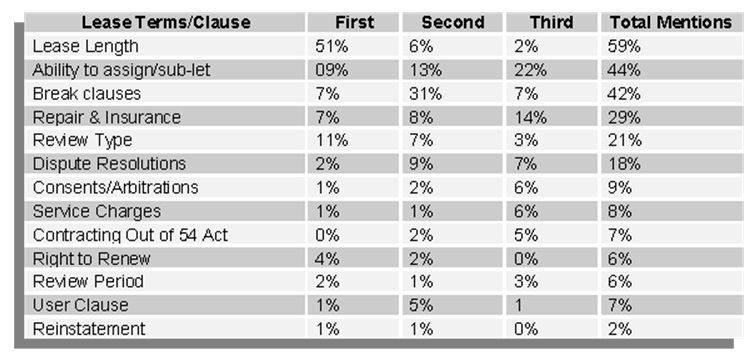
References
Pemberton Greenish, Enfranchisement, “Property Management and Commonhold- A summary of the current law on enfranchisement and an introduction to the changes in the law introduced by the Commonhold and Leasehold Reform Act 2002”, (Pemberton Greenish, 45 Pont Street, London SW1X 0BX), October 2002.
Department of Land Management and Development, “A Report on the Attitudes of Occupiers in the UK’, The University of Reading, RG6 6AW, February 2001.
Explanatory Notes-“Commonhold and Leasehold Reform Act 2002”, The Commonhold and Leasehold Reform Act 2002 (c.15).
Gerry Fox, FRICS, “Commonhold and Leasehold Reform Act 2002”, Peverel OM Limited, Marlborough house, Wigmore Place, Bedfordshire LU2 9EX, October 2004.
Ryan Kevin FRICS, “Leasehold Enfranchisement”, Carter Jonas Residential Division, UK, 2005.
LON/NL/06, “Leasehold Valuation Tribunal for The London Rent Assessment Panel”, Decision Of The Leasehold Valuation Tribunal On Application Under Section 48 Of The Leasehold Reform, (Housing And Urban Development) Act 1993, 2006.
Baker Chris, “Commonhold –Oakgrove”, Millennium Communities Partners’Network -2006.
OLR (Office of Law Reform), “Review of the Operation of the Ground Rents Act (Ni) 2001”, Discussion Paper 1/05, 2005.
Bill Peter, “Affordable Housing”, T he Smith Institute, ISBN 1 902488 86 5, 2005.
Ford Margaret, “The Concept in which we work”, The Smith Institute, 2005.
Power Anne, “Housing and society”, The Smith Institute & London School of Economics, London, SW1W 0AW, 2005.
Livingstone Ken, “Bold moves to rebalance the London market”, The Smith Institute, 2005.
Wilson Wendy, “ The Commonhold and Leasehold Reform Bill, HL Bill 51 of 2001-02”, Research Paper-R 01/115, House of Commons Library, Social Policy Section, 2001.
Radevsky Anthony and Greenish Damian, “Hague on Leasehold Enfranchisement”, Maxwell’s Property & Conveyancing Library, 2003.
CLRA-2002/Sections 11-24, Commonhold and Leasehold Reform Act 2002.
Rosenberry Katharine, Joseph Rowntree Foundation, 2000.
Explanatory Memorandum To The Commonhold Regulations 2004 No. 2004/2004.
Survey Questionnaire
- What is the ownership status of your company?
- 100% Private
- 100% Government
- 50% Gov. & 50% Private
- ….% Gov. & …..% Private
- Has Foreign collaboration
- Has public stocks
- Did your company face any changes in business conditions over the years? If ‘yes’ then identify three significant changes?
- Yes, there have been changes
- Severe market competitions
- Extended domestic market
- Internationalization
- Stringent regulations
- No changes
- What was your firm’s pattern of profit earnings for the last three years?
- Earned profits :
- 2003
- 2004
- 2005
- Earned losses :
- 2003
- 2003
- 2005
- Breakeven : □ 2003 □ 2004 □ 2005
- How many staffs your company has in the UK?
- Less than 20
- 20-100
- 100-500
- 500-1000
- 1000-5000
- More than 5000
- Is your company considering building a commonhold development now that the new Act is in force?
- Yes
- No
- How many commonhold developments would you like to build initially?
- 0
- 1-5
- 6-10
- 11-20
- 21-50
- 51-100
- Over 100
- Others…
- What type of commonhold you would like to build?
- Residential
- Commercial
- Mixed
- Residential+Mixed
- Commercial+Mixed
- Resi.+Comm.+Mixed
- None/Others…
- Which one of the following best reflects your company’s satisfaction with the UK leasehold system?
- Property market responsive & no problems faced in getting leases when we need.
- Some difficulties exist with certain aspects of the current UK leasehold system but overall it operates satisfactorily.
- The UK leasehold system is unsatisfactory and it does not fit well with the current fast moving business situation.
- Any other………………………………….
- Please identify the lease terms/clauses that are problematic for you as an occupier.
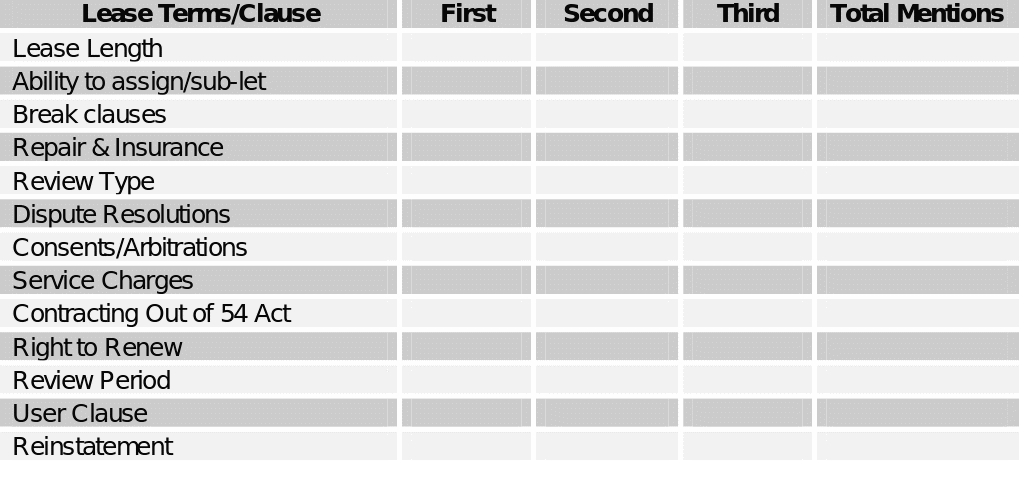
Footnotes
- Pemberton, 2002.
- Explanatory Notes, 2002.
- Gerry Fox, 2004.
- Ryan Kevin, 2005.
- Pemberton, 2002.
- See, LON/NL/06, 2006.
- OLR, 2005.
- Baker, 2006.
- Pemberton, 2002.
- Ryan Kevin, 2005.
- LON/NL/06, 2006.
- Bill Peter, 2005.
- Baker, 2006.
- Ryan Kevin, 2005.
- Ford Margaret, 2005.
- Bill Peter, 2005.
- Baker, 2006.
- Ryan Kevin, 2005.
- Power Anne, 2005.
- Livingstone, 2005.
- Ryan Kevin, 2005.
- Pemberton, 2002.
- Ryan Kevin, 2005.
- Radevsky & Greenish, 2003.
- Wilson, 2001.
- Explanatory Notes, 2002.
- Ryan Kevin, 2005.
- Pemberton, 2002.
- Section 11-24, CLRA-2002.
- Radevsky & Greenish, 2003.
- Wilson, 2001.
- Explanatory Memorandum, 2004.
- Explanatory Memorandum, 2004.
- Explanatory Memorandum, 2004.
- Kumar, 1996.
- Yin, 1994; Yin, 2003.
- Wiederssheim-Paul & Eriksson, 1997.
- Wiederheim- Paul & Ericksson, 1997. ; Patel & Tabelius, 1987.
- Reynolds, 1971.
- Hair et al., 2000.
- Yin, 1993. Holme & Solvang, 1991. Hair et al., 2000.
- Ogier, 1998. McDaniel & Gates, 2001. Daum Juergen, 2005.
- Yin, 2003.
- Lundahl & Skarvad, 1992.